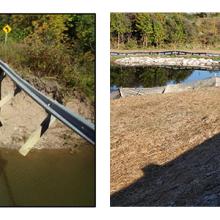Image set

Related services
Opening article section
Article section
Lead
Rich text
Since the spring of 2019, New Brunswick, Canada has been impacted by three separate disaster events which have damaged more than 750 Department of Transportation sites across the province. First, the spring freshet (or spring thaw) caused significant runoff which resulted in high river levels in the Saint John river valley and other areas for a second straight year. Following that, more destruction occurred as a result of Hurricane Dorian in September. The third event was a heavy rain storm on and around December 1, 2020.
Englobe has been working with the New Brunswick Department of Transportation and Infrastructure to manage and administer the recovery from these events that have significantly impacted public infrastructure.
Rich text
DFAP
The Disaster Financial Assistance Program (DFAP) is a federal program through which the Government of Canada shoulders the provinces’ cost of recovering damaged infrastructure following a significant disaster event. This allows the infrastructure to be replaced or rebuilt in a timely manner without additional financial burden to the province.
Englobe Project Manager, Mike Rogers notes that as these types of events have increased in number and frequency, the participation of engineering firms has evolved too: “Most of our work has been focused on the essential infrastructure that keeps our society moving. Collapsed culverts, failed embankments, and damaged seawalls can interrupt the flow of traffic on our highways and roadways which affects all New Brunswickers as they travel to work, home, school, etc.”
Rich text
How it works
The project consists, in part, of a condition assessment of damaged culverts, embankments, roadways, as well as some bridge structures. Assessments include field inspections, condition ratings, cost estimates for repairs, and the development of recovery measures. All of the damage sites were entered into a central web-based registry for tracking purposes and a plan was then developed for recovery at each site. For sites that required design services, a consultant was engaged to provide these services and manage the design and construction of the recovery work.
Beyond this, project sites involving any significant excavation are screened by the Archaeology and Heritage Branch of the Government of New Brunswick. Many projects are also reviewed and approved by the New Brunswick Department of Environment and Local Government (NBDELG) for work in proximity to wetlands and watercourses.
The DFAP has covered several culvert replacements, embankment repairs, a bridge replacement, shoulder repairs, culvert cleaning and resetting, and some general cleanup of debris. In the photos below, we can see the “before” and “after” results of a dramatic disaster event that occurred in 2015, and its subsequent recovery that Englobe has the priviledge of partnering with other consultants, and the provincial and federal governments to achieve.